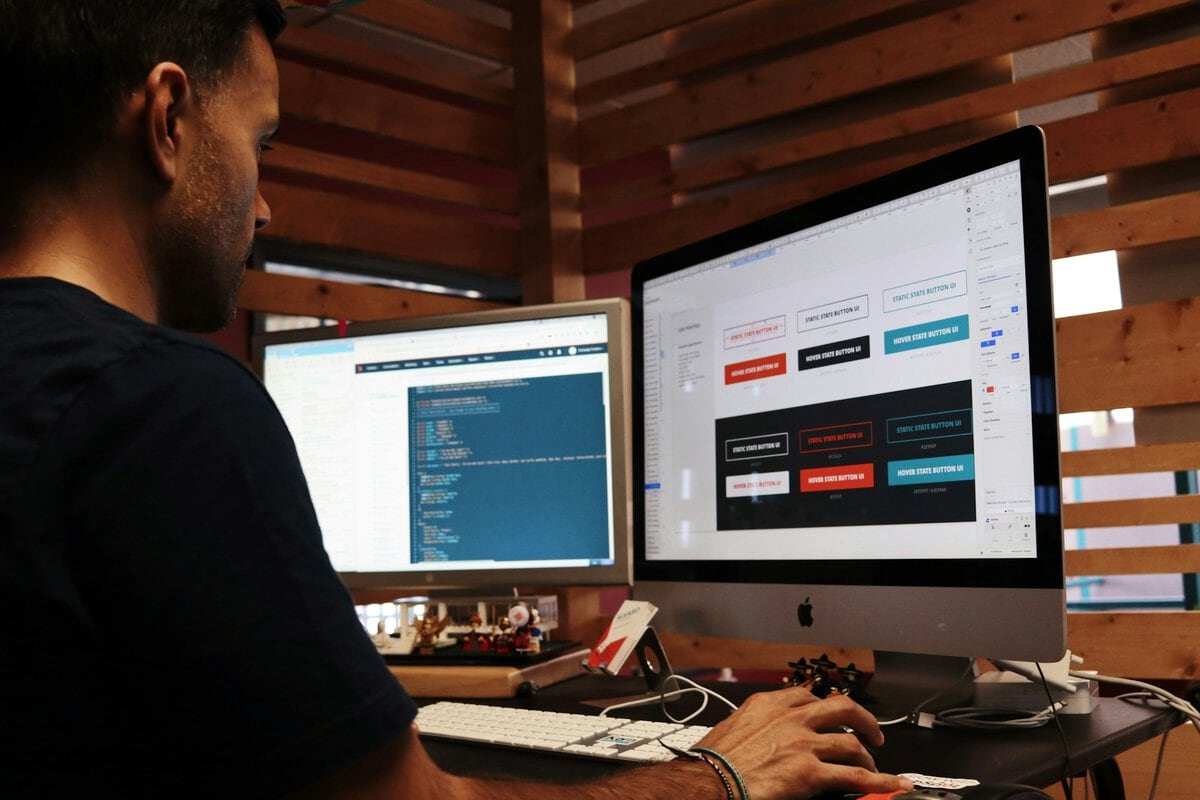Starting the website development process can be incredibly frustrating for beginners. Without extensive background knowledge and experience, developing a fully functional website from scratch can often be too much to handle. Thankfully, this doesn’t always have to be the case. With the right tools and a bit of guidance, even beginners can successfully build decent websites with relative ease. All it takes is a clear understanding of the basics, a willingness to learn, and access to the right resources.

In this article, we will provide you with all the basic information you’ll need as an absolute beginner looking to start your web development journey, providing you with a step-by-step guide you can follow. Before diving into the main content of the article, however, it is essential to first address the big question:
What is Website Development?
To put it simply, website development is the complete website creation process. The process of website building from scratch involves everything from designing how the website looks to building the site, uploading its content, and managing its functionalities. Unlike other disciplines like web design or web programming which focus on specific parts of the website creation process, web development encompasses the entire journey of bringing a website to life. This makes web development a more complicated activity since essentially, a web developer is expected to bring all the other disciplines together.
What are the Other Disciplines in the Website Creation Process
The complete website creation process encompasses several disciplines, all of which are essential for creating a fully functional website. Anyone looking to develop a website must be reasonably proficient in some combination of these disciplines or the other. In our opinion, there are three main disciplines every web developer should hold at least some proficiency in:
- Web Design — This is the process of creating the look of the website. It involves everything from designing the user interface (UI) of the website to its user experience (UX).
- Front-End Development — This is the process of web development that focuses on building the part of the website that the user interacts with. This is the part of the web development process that breathes life into the web design.
- Back-End Development — This is the process of web development that focuses on the server-side functionality of the website. This includes everything from managing databases to ensuring server operations run smoothly making back end Development a crucial aspect of creating a fully functional website.
Other important, but not necessary, disciplines include:
- Search Engine Optimization (SEO)
- Content Development
- Quality Assurance (QA) Testing
- Cybersecurity
As a web developer, you do not have to be an expert in all the disciplines mentioned above. Many web developers choose to specialize in just one or two areas and collaborate with other professionals (e.g., a WP or Webflow design agency) to handle the rest.
Now that you know what website development is and the several disciplines involved in creating a website from scratch, it’s time we move on to the fun stuff.
Understanding the Website Development Process

Typically, the web development process can look different depending on the type of website being created and the preferred approach of the developer. For the most part, however, the process would follow something along these lines:
Step 1: Preparation
Before starting any project, you’ll always want to prepare for the task at hand. Website development is no exception. You want to make sure you have all you need to successfully complete the project BEFORE you actually get started with the project. Getting this step wrong would often lead to a ton of frustration down the line.
During the preparation stage of building a website, you’d want to gather as much information about the website as you can. Here’s the part where you want to ask questions like:
- What type of website do you need?
- How many pages are you looking to have on the website?
- What is the purpose of the website and what goals do you have in mind?
- What features do you expect the website to have?
You’d also want to ask questions about the project itself. Questions like:
- What is the budget for the project?
- What is the expected timeline?
You’d want to ask these questions whether or not you are creating the website for yourself or for someone else.
Step 2: Planning and Strategy
Once you have all the information you can about the website, it is time to start planning out how to go about creating the website. This is the most important part of the website creation process; fail at this stage and you’ll end up with a website that falls short of its full potential.
The planning and strategy part of the website creation process is where you take into account everything you learned from your information-gathering and then create a reliable execution plan.
As a beginner web developer, you want to have as detailed an execution plan as possible. This plan should cover everything including the tools you’ll use, your sitemap, and the different milestones you’d have to cross on the roadmap to completing the project.
In many ways, the sitemap is the most important part of the planning and strategy stage. This is where most of the information gathered during step one comes into play. A sitemap serves as the blueprint of the website, detailing the basic structure of the website and listing the major pages the site would contain and how they would be interconnected and organized. The sitemap tells you what pages the website will have, helps you visualize how each page connects to the rest of the website, and helps you visualize how viewers can move from one to the next.
Apart from your sitemap, you’d also want to pay special attention to the tools you’ll employ during the website creation process here. This is where you’d decide whether or not you’d use a web builder like WordPress or code the website from scratch. Whether you’d make use of UI/UX design tools like Figma or simply wireframe with a pen and paper. It’s where you’d decide whether you’d use a free hosting platform or choose a paid option.
So basically, this is the part of the website creation process where you mentally break down how the entire project would go before you begin the “real” work of creating the website.
Step 3: Design

The design phase is where the real work starts. With the structure of the website having been created in step 2, it’s time to start turning that sitemap into something more concrete.
In the design phase of the website creation process, developing a wireframe is probably the most important thing for beginners. A wireframe is a visual guide that represents the layout of each page of your website. Basically, it is a tool that helps you create and visualize how your website will look before you actually begin the process of designing the website.
A wireframe includes all the key elements found on your page arranged how they’d be expected to be arranged on the page. The wireframe showcases the layout of the page and where visual elements like images, menus, text blocks, and buttons will be. Basically, it provides a visual model of the website which can then be used for the actual design. You can create a wireframe with a simple pen and paper or make use of design tools like Figma or Adobe XD.
When designing your website, make sure to use a user-friendly design, one that is clean and easy to navigate. This would help ensure you have a website that is not just functional, but also one that is aesthetic and provides a great user experience.
Step 4: Coding or Use of Web Builders
Now’s when everything starts coming together and you start converting your design into a functional website. Usually, this would involve some form of coding, but in today’s world, web builders like WordPress, Wix, and Squarespace can be used, bypassing the need for coding. Web builders like these are a great choice, especially for beginners with little to no coding experience.
As a beginner, you’d probably want to stick to making use of simple drag-and-drop web builders. You’d want to make sure whichever one you choose though, you take the budget for the project into consideration as many of these tools offer paid plans. You could also use free plans, though some tools might not offer those and free plans often come with limited functionality.
When building the site, whether by coding or using a web builder, remember to use the design you created in the previous step as your guideline. You have already created a design that is functional, beautiful, and user-friendly. All you need to do is use this step to bring that design and all its functionalities to life.
Step 5: Content
Content is one of, if not the most important part, of the website. After all, the purpose of a website is to have a site on the web for content to be housed and displayed. Hence, as much attention, if not even more, should be paid to this part of the website creation process.
When we talk of content, we mean everything from text to images, video, charts, and other media elements that communicate the website’s message and serve its purpose. Depending on the type of website, content goals, and several other factors, like keywords, target audience demographic, and the desired tone and style, the content on a website would vary.
Since website content creation on its own is also an incredibly broad field, it is not uncommon for web developers to outsource this part of the website creation process to specialized website content developers. This is a great option for both beginners and experienced developers alike, and as a beginner, we recommend you consider this option. This way, you can leave the content writing to an expert and just upload the provided content once you are done with the web-building phase.
Note: Some developers prefer to carry out content creation first before they begin building the website. There is nothing wrong with this approach, in fact, as an experienced developer, this is a better choice. For a beginner who’s better off outsourcing the content creation, however, we recommend building the website first and making use of dummy texts and images to prevent delays in the development process.
Step 6: Testing
Once the content has been uploaded to the website, your website is practically ready for launch. Before going ahead with getting the website live though, you’d want to first carry out some testing to ensure the website is functioning the way it should. Here’s where you’d test every link and button on the website, making sure every embedded item is functioning as it should and that there are no inconsistencies and errors to be seen on your site. You’ll also want to take a look at your content to make sure there are no errors or inconsistencies. This can often be a tedious process, but it is an essential step that ensures that when you actually launch the website, what you present to the world is the best possible version of the website you created
Step 7: Launch
Finally, this is the part you have most likely been waiting for; the part where you put your newly created website out there for the world to see! In some cases, like when creating a website with a web builder like WordPress’s free version, launching your website is as simple as hitting the Launch Button. Other times, however, launching the site might involve uploading the website on a hosting platform. Once you are done with this, however, the website will be live and ready to be viewed by users on the internet!
After launching the website, it’s always a good idea to test the site one more time to make sure that everything is as it should be. If you notice any issues, go back to make the necessary changes and update your changes until you are satisfied that the website is as perfect as you can make it.
Conclusion
Creating a website from scratch can be a truly intimidating task for beginners with little to no experience. However, the process becomes much easier to manage when you know the steps to take. While the steps you take may vary depending on the type of website you are looking to build and your unique needs, it usually follows a similar process to what you have above.
Site builders like WordPress and its alternatives greatly simplify the process and are a great choice for beginners. With these tools, you can create functional and visually appealing websites without needing extensive coding knowledge. However, as you grow more comfortable with web development, you may find it beneficial to explore coding and other advanced techniques to unlock greater customization and flexibility.
Finally, it is always important to remember that you do not have to handle every part of the web development process yourself, you could always focus on your strengths and outsource your weaknesses to individuals who specialize in that part of the website creation process. This would not only help reduce the pressure you feel but also improve the quality of your work all around and build your experience.

